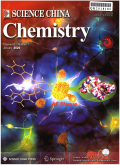- 钛学术文献服务平台 \
- 学术期刊 \
- 基础科学期刊 \
- 自然科学总论期刊 \
- 中国科学:化学(英文版)期刊 \
Atom-by-atom fabrication of metal clusters for efficient selective hydrogenation
Atom-by-atom fabrication of metal clusters for efficient selective hydrogenation
基本信息来源于合作网站,原文需代理用户跳转至来源网站获取
摘要:
Supported metal catalysts,in which the metal is usually fi-nely dispersed into nanoparticles(NPs)in size of a few nanometers on high-surface-area materials,are the work-horses in heterogeneous catalysis and have been extensively used in various key industrial processes[1].However,the surface heterogeneity arising from the uneven size distribu-tion as well as the lower atomic efficiency derived from the presence of unexposed interior atoms of metal NPs often leads to inferior activity/selectivity.On the other hand,the recently emerged single-atom catalysts(SACs),consisting of isolated metal atoms singly dispersed on supports,have at-tracted intensive attention due to their various advantages in comparison with NPs,including the maximized atomic ef-ficiency and relatively homogenous active sites[2,3].Nevertheless,the lack of cooperation from neighboring metal atoms may suppress the intrinsic activity of SACs in certain reactions.Therefore,the supported ultra-small clus-ters containing a few metal atoms that can provide catalytic sites with collective metal atoms and meanwhile maintain full atomic utilization efficiency,often being called as sup-ported atomically dispersed catalysts(SADCs)or fully ex-posed cluster catalysts(FECCs)[4],are regarded as the next generation of catalysts to bridge SACs and metal NPs.However,practically fabricating and stabilizing these clus-ters,especially with identical structure,remain a daunting challenge.

推荐文章
基于 Atom510的校车安全监控管理系统设计
校车
安全监控
嵌入式
物联网
Atom510
基于凌动处理器ATOM-510的车载信息终端设计
Intel Atom
嵌入式系统
GPS
GPRS
车载信息终端
ATOM P-600输液泵常见故障及检修
输液泵
超声传感器
医疗设备维修
内容分析
关键词云
关键词热度
相关文献总数
(/次)
(/年)
文献信息
| 篇名 | Atom-by-atom fabrication of metal clusters for efficient selective hydrogenation | ||
| 来源期刊 | 中国科学:化学(英文版) | 学科 | |
| 关键词 | |||
| 年,卷(期) | 2022,(2) | 所属期刊栏目 | HIGHLIGHTS |
| 研究方向 | 页码范围 | 202-203 | |
| 页数 | 2页 | 分类号 | |
| 字数 | 语种 | 英文 | |
| DOI | |||
五维指标
引文网络
引文网络
二级参考文献 (0)
共引文献 (0)
参考文献 (0)
节点文献
引证文献 (0)
同被引文献 (0)
二级引证文献 (0)
2022(0)
- 参考文献(0)
- 二级参考文献(0)
- 引证文献(0)
- 二级引证文献(0)
引文网络交叉学科
相关学者/机构
期刊影响力
中国科学:化学(英文版)
主办单位:
中国科学院
出版周期:
月刊
ISSN:
1674-7291
CN:
11-5839/O6
开本:
16开
出版地:
北京东黄城根北街16号
邮发代号:
创刊时间:
1950
语种:
eng
出版文献量(篇)
4060
总下载数(次)
0
总被引数(次)
11421
期刊文献
相关文献
推荐文献
- 期刊分类
- 期刊(年)
- 期刊(期)
- 期刊推荐
力学
化学
地球物理学
地质学
基础科学综合
大学学报
天文学
天文学、地球科学
数学
气象学
海洋学
物理学
生物学
生物科学
自然地理学和测绘学
自然科学总论
自然科学理论与方法
资源科学
非线性科学与系统科学
中国科学:化学(英文版)2022
中国科学:化学(英文版)2021
中国科学:化学(英文版)2020
中国科学:化学(英文版)2019
中国科学:化学(英文版)2018
中国科学:化学(英文版)2017
中国科学:化学(英文版)2016
中国科学:化学(英文版)2015
中国科学:化学(英文版)2014
中国科学:化学(英文版)2013
中国科学:化学(英文版)2012
中国科学:化学(英文版)2011
中国科学:化学(英文版)2010
中国科学:化学(英文版)2009
中国科学:化学(英文版)2008
中国科学:化学(英文版)2007
中国科学:化学(英文版)2006
中国科学:化学(英文版)2005
中国科学:化学(英文版)2004
中国科学:化学(英文版)2003
中国科学:化学(英文版)2002
中国科学:化学(英文版)2001
中国科学:化学(英文版)2000

 免费查重
免费查重










